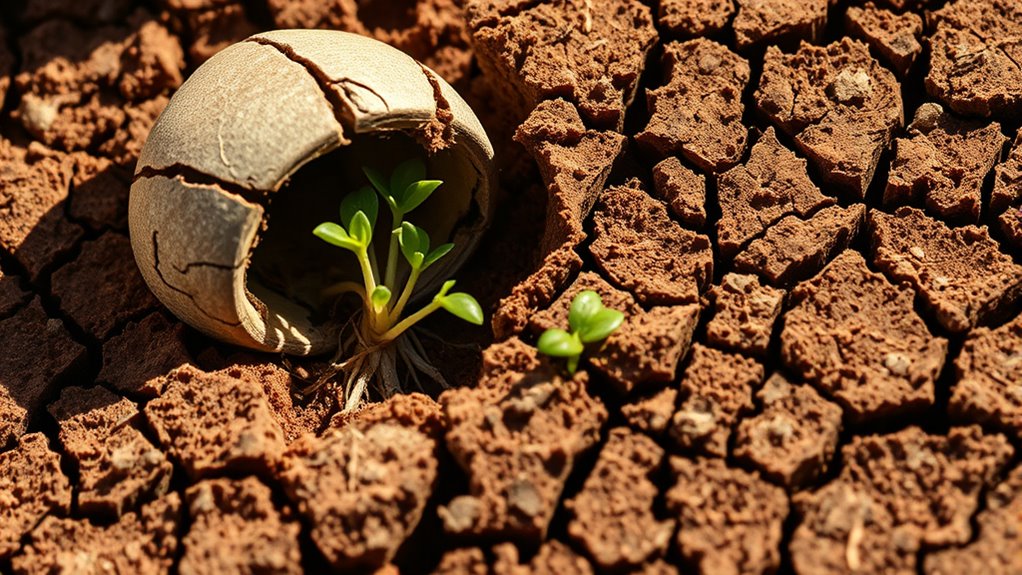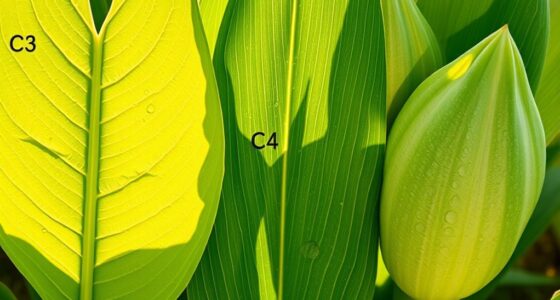Some seeds need high temperatures to sprout because warmth activates essential biochemical processes and enzymes that break dormancy. This temperature sensitivity ensures seeds only germinate when conditions are ideal, reducing the risk of damage from cold or frost. Warmth triggers metabolic shifts necessary for growth, signaling to the seed that it’s time to sprout. If you want to understand more about how heat influences seed behavior, keep exploring the details behind this crucial process.
Key Takeaways
- High temperatures activate specific enzymes essential for breaking seed dormancy and initiating germination.
- Some seeds have evolved to require warmth as an environmental cue indicating favorable growing conditions.
- Elevated heat accelerates metabolic and biochemical processes necessary for seed sprouting.
- Warmth ensures seeds germinate during optimal seasons, reducing risks like frost damage.
- Providing high-temperature conditions can break dormancy faster and promote healthier seedling development.

Many seeds require heat to break dormancy and kickstart germination because warmth triggers essential biochemical processes. Seed dormancy is a natural mechanism that prevents seeds from sprouting until the conditions are just right. For some seeds, this dormancy persists until they experience specific environmental cues, particularly temperature cues. When you plant these seeds in cold soil or in conditions lacking sufficient warmth, they remain inert, delaying germination. It’s only when they encounter the right temperature range that they begin to wake up and start growing.
In nature, temperature fluctuations signal the changing seasons, alerting seeds that the time to sprout is near. These fluctuations are vital for certain species, especially those that have evolved to wait for specific seasonal cues. You might notice this if you plant seeds during early spring but see no growth because the soil isn’t yet warm enough. As the days lengthen and the sun’s warmth increases, the soil temperature rises within the ideal range for germination. During this period, biochemical processes like enzyme activation and metabolic shifts accelerate, breaking seed dormancy and initiating sprouting. Without this warmth, these processes remain dormant, and germination is effectively paused.
The importance of temperature fluctuations becomes clear when you consider how some seeds are programmed to wait through cold periods before sprouting. This strategy ensures that seedlings don’t emerge during harsh winter conditions, which could jeopardize their survival. Instead, they wait for the soil to warm consistently, reducing the risk of frost damage and ensuring they have enough growing season ahead. When you’re trying to germinate such seeds, providing a stable, warm environment mimicking natural temperature changes can greatly improve success rates. Additionally, understanding the role of temperature range helps in selecting the ideal conditions for different seed types, increasing germination efficiency.
Understanding the role of heat in breaking seed dormancy can help you manipulate conditions to speed up germination. If you’re working with seeds that need heat, you might use a seedling heat mat or place the seeds in a warm, sunny location. Be mindful of temperature fluctuations—some seeds require a temperature swing to signal that the environment is suitable for sprouting. Keeping the soil or medium consistently warm, but not overly hot, ensures that biochemical processes proceed smoothly. This approach can reduce dormancy periods, leading to quicker sprouting and healthier seedlings.
In essence, recognizing how temperature fluctuations influence seed dormancy helps you create the perfect conditions for germination. By understanding these natural cues and providing appropriate warmth, you encourage seeds to awaken from dormancy and grow vigorously, giving your plants the best start possible.
Frequently Asked Questions
Can Heat-Triggered Germination Be Artificially Simulated Indoors?
You can definitely simulate heat-triggered germination indoors by controlling temperature conditions. This mimics natural germination triggers, helping break seed dormancy. Use a heat mat or warm environment to provide the high temperatures seeds need to sprout. Keep in mind, understanding specific seed requirements guarantees successful germination. Monitoring soil temperature closely is key, so you can provide just the right amount of heat without damaging the seeds.
Do All Plant Species Rely on High Temperatures to Sprout?
You might wonder if all plant species rely on high temperatures to sprout. Not necessarily. Some seeds have seed dormancy, requiring specific temperature thresholds to break dormancy and germinate. Others sprout in cooler conditions or even without temperature cues. While heat triggers germination in many plants, each species adapts uniquely, balancing environmental signals to guarantee successful growth. So, no, not all plants depend on high temperatures for sprouting.
How Does Climate Change Affect Heat-Dependent Seed Germination?
Climate change impacts heat-dependent seed germination by altering temperature patterns, which can disrupt ideal conditions for sprouting. You might notice changes in soil moisture levels, affecting seed viability and making it harder for seeds to sprout successfully. As temperatures fluctuate unpredictably, some seeds may fail to germinate or sprout prematurely, threatening plant populations and ecosystems. Adjusting planting times and conserving soil moisture can help mitigate these effects.
Are There Any Risks Associated With Exposing Seeds to High Temperatures?
You might worry about exposing seeds to high temperatures, but it can pose risks like seed damage or germination failure. Excessive heat can harm the seed’s internal structures, preventing it from sprouting properly. To avoid these issues, make certain temperatures stay within the ideal range for your seed type. Properly managing heat exposure helps protect the seed’s viability and increases the chances of successful germination.
What Are Some Common Techniques to Break Seed Dormancy Using Heat?
You can break seed dormancy using heat through techniques like seed scarification, which involves scratching or nicking the seed coat to allow water entry, and thermal stratification, where you expose seeds to high temperatures followed by cooling to mimic natural conditions. These methods help overcome natural barriers, encouraging germination. Be sure to monitor temperature carefully to avoid damaging the seeds, ensuring successful sprouting.
Conclusion
So, next time you’re waiting for those stubborn seeds to sprout, remember that some need the heat of summer’s blaze, much like ancient mariners relied on the sun’s warmth to guide their ships. By understanding how high temperatures trigger germination, you can better care for your garden or farm. Don’t forget, patience is a virtue—sometimes, Mother Nature just needs a little extra heat to wake your seeds from their slumber and start fresh growth.










